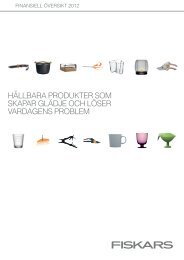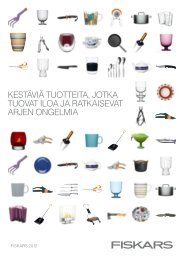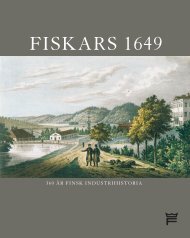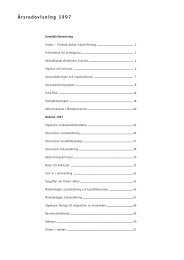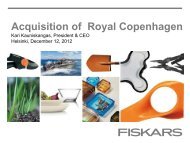FISKARS 1649 â 360 years of Finnish industrial history
FISKARS 1649 â 360 years of Finnish industrial history
FISKARS 1649 â 360 years of Finnish industrial history
You also want an ePaper? Increase the reach of your titles
YUMPU automatically turns print PDFs into web optimized ePapers that Google loves.
Fiskars <strong>1649</strong><br />
Fiskars <strong>1649</strong><br />
A narrow-gauge railway was built between Fiskars and the harbor at Pohjankuru in 1891. This locomotive, known as<br />
Pikkupässi (Little Ram), was still in use when the track was closed in 1952.<br />
Originally build as a plow workshop in 1914, this building was extended to include new factory space in the 1970s. Today, it<br />
houses workshops and <strong>of</strong>fices.<br />
Next Page: The upper works in the 1920s. Some <strong>of</strong> the warehouses have been pulled down, as has the rolling mill in the middle<br />
<strong>of</strong> the picture. Fiskars had its own narrow-gauge railway, which ran all the way to Pohjankuru harbour.<br />
cowshed behind Åkerraden was completed in<br />
1921. In the upper works area, the extension to<br />
the machine workshop, the product workshop, a<br />
long factory building made <strong>of</strong> coccolith, various<br />
outbuildings and three <strong>of</strong> the Hasselbacka<br />
tenements (the fourth was destroyed by fire in<br />
1986) have been preserved. The Suutarinmäki<br />
housing development was built northwest <strong>of</strong> the<br />
ironworks. As the number <strong>of</strong> workers increased,<br />
the company built new housing further away from<br />
the central production areas. Fiskars employees<br />
were also allowed to build small cottages or houses<br />
for recreational use on company land. The factory<br />
hospital completed in 1892 still stands on the<br />
eastern shore <strong>of</strong> Ålsviken bay.<br />
Old ironworks communities such as Fiskars were<br />
obviously different from those in farming villages<br />
or in towns. They also differed from the <strong>industrial</strong><br />
communities that emerged in the 1870s and 1880s.<br />
The ironworks owner held absolute sway, and<br />
in spite <strong>of</strong> technological advances, the ironworks<br />
have reflected old handicraft traditions right up<br />
to our time. Thus the ironworks industry and its<br />
various sub-sectors should be seen as a historical<br />
phenomenon dating back to the 17th century which<br />
has greatly enriched Finland’s culture.<br />
The Fiskars ironworks town plan is made up<br />
<strong>of</strong> areas concentrating on administration, industry,<br />
agriculture and dwellings. The buildings include<br />
different structures for industry, agriculture, storage<br />
and housing. Apart from the buildings, the entire<br />
ironworks milieu also takes in rivers, reservoirs,<br />
bridges, roads with planted trees, gardens, and the<br />
surrounding fields and forests.<br />
72<br />
73




